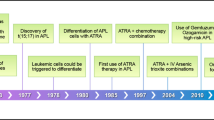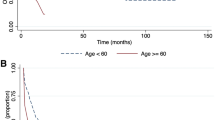Abstract
Our knowledge about acute promyelocytic leukemia (APL) patients is mainly based on data from clinical trials, whereas population-based information is scarce. We studied APL patients diagnosed between 1997 and 2006 in the population-based Swedish Adult Acute Leukemia Registry. Of a total of 3897 acute leukemia cases, 3205 (82%) had non-APL acute myeloid leukemia (AML) and 105 (2.7%) had APL. The incidence of APL was 0.145 per 100 000 inhabitants per year. The median age at the time of diagnosis was 54 years; 62% were female and 38% male. Among younger APL patients, female sex predominated (89% of patients <40 years). Of the 105 APL patients, 30 (29%) died within 30 days (that is, early death (ED)) (median 4 days) and 28 (26%) within 14 days from diagnosis. In all, 41% of the EDs were due to hemorrhage; 35% of ED patients never received all-trans-retinoic acid treatment. ED rates increased with age but more clearly with poor performance status. ED was also associated with high white blood cells, lactate dehydrogenase, creatinine, C-reactive protein and low platelet count. Of non-ED patients, 97% achieved complete remission of which 16% subsequently relapsed. In total, 62% are still alive at 6.4 years median follow-up. We conclude that ED rates remain very high in an unselected APL population.
This is a preview of subscription content, access via your institution
Access options
Subscribe to this journal
Receive 12 print issues and online access
$259.00 per year
only $21.58 per issue
Buy this article
- Purchase on Springer Link
- Instant access to full article PDF
Prices may be subject to local taxes which are calculated during checkout



Similar content being viewed by others
References
Lo-Coco F, Ammatuna E, Montesinos P, Sanz MA . Acute promyelocytic leukemia: recent advances in diagnosis and management. Semin Oncol 2008; 35: 401–409.
Wang ZY, Chen Z . Acute promyelocytic leukemia: from highly fatal to highly curable. Blood 2008; 111: 2505–2515.
Fenaux P, Chastang C, Chevret S, Sanz M, Dombret H, Archimbaud E et al. A randomized comparison of all transretinoic acid (ATRA) followed by chemotherapy and ATRA plus chemotherapy and the role of maintenance therapy in newly diagnosed acute promyelocytic leukemia. The European APL Group. Blood 1999; 94: 1192–1200.
Sanz MA, Martin G, Gonzalez M, Leon A, Rayon C, Rivas C et al. Risk-adapted treatment of acute promyelocytic leukemia with all-trans-retinoic acid and anthracycline monochemotherapy: a multicenter study by the PETHEMA group. Blood 2004; 103: 1237–1243.
Lengfelder E, Haferlach C, Saussele S, Haferlach T, Schultheis B, Schnittger S et al. High dose ara-C in the treatment of newly diagnosed acute promyelocytic leukemia: long-term results of the German AMLCG. Leukemia 2009; 23: 2248–2258.
Sanz MA, Montesinos P . Open issues on bleeding and thrombosis in acute promyelocytic leukemia. Thromb Res 2010; 125 (Suppl 2): S51–S54.
Breccia M, Latagliata R, Cannella L, Minotti C, Meloni G, Lo-Coco F . Early hemorrhagic death before starting therapy in acute promyelocytic leukemia: association with high WBC count, late diagnosis and delayed treatment initiation. Haematologica 2010; 95: 853–854.
Asou N, Adachi K, Tamura J, Kanamaru A, Kageyama S, Hiraoka A et al. All-trans retinoic acid therapy for newly diagnosed acute promyelocytic leukemia: comparison with intensive chemotherapy. The Japan Adult Leukemia Study Group (JALSG). Cancer Chemother Pharmacol 1997; 40 (Suppl): S30–S35.
Fenaux P, Le Deley MC, Castaigne S, Archimbaud E, Chomienne C, Link H et al. Effect of all transretinoic acid in newly diagnosed acute promyelocytic leukemia. Results of a multicenter randomized trial. European APL 91 Group. Blood 1993; 82: 3241–3249.
Tallman MS, Andersen JW, Schiffer CA, Appelbaum FR, Feusner JH, Ogden A et al. All-trans-retinoic acid in acute promyelocytic leukemia. N Engl J Med 1997; 337: 1021–1028.
de la Serna J, Montesinos P, Vellenga E, Rayon C, Parody R, Leon A et al. Causes and prognostic factors of remission induction failure in patients with acute promyelocytic leukemia treated with all-trans retinoic acid and idarubicin. Blood 2008; 111: 3395–3402.
Di Bona E, Avvisati G, Castaman G, Luce Vegna M, De Sanctis V, Rodeghiero F et al. Early haemorrhagic morbidity and mortality during remission induction with or without all-trans retinoic acid in acute promyelocytic leukaemia. Br J Haematol 2000; 108: 689–695.
De Botton S, Dombret H, Sanz M, Miguel JS, Caillot D, Zittoun R et al. Incidence, clinical features, and outcome of all trans-retinoic acid syndrome in 413 cases of newly diagnosed acute promyelocytic leukemia. The European APL Group. Blood 1998; 92: 2712–2718.
Montesinos P, Bergua JM, Vellenga E, Rayon C, Parody R, de la Serna J et al. Differentiation syndrome in patients with acute promyelocytic leukemia treated with all-trans retinoic acid and anthracycline chemotherapy: characteristics, outcome, and prognostic factors. Blood 2009; 113: 775–783.
Juliusson G, Antunovic P, Derolf A, Lehmann S, Mollgard L, Stockelberg D et al. Age and acute myeloid leukemia: real world data on decision to treat and outcomes from the Swedish Acute Leukemia Registry. Blood 2009; 113: 4179–4187.
Sanz MA, Lo Coco F, Martin G, Avvisati G, Rayon C, Barbui T et al. Definition of relapse risk and role of nonanthracycline drugs for consolidation in patients with acute promyelocytic leukemia: a joint study of the PETHEMA and GIMEMA cooperative groups. Blood 2000; 96: 1247–1253.
Bennett JM, Catovsky D, Daniel MT, Flandrin G, Galton DA, Gralnick HR et al. Proposed revised criteria for the classification of acute myeloid leukemia. A report of the French-American-British Cooperative Group. Ann Intern Med 1985; 103: 620–625.
Matasar MJ, Ritchie EK, Consedine N, Magai C, Neugut AI . Incidence rates of acute promyelocytic leukemia among Hispanics, blacks, Asians, and non-Hispanic whites in the United States. Eur J Cancer Prev 2006; 15: 367–370.
Douer D, Preston-Martin S, Chang E, Nichols PW, Watkins KJ, Levine AM . High frequency of acute promyelocytic leukemia among Latinos with acute myeloid leukemia. Blood 1996; 87: 308–313.
Ruiz-Arguelles GJ . Promyelocytic leukemia in Mexican Mestizos. Blood 1997; 89: 348–349.
Tomas JF, Fernandez-Ranada JM . About the increased frequency of acute promyelocytic leukemia among Latinos: the experience from a center in Spain. Blood 1996; 88: 2357–2358.
Jacomo RH, Melo RA, Souto FR, de Mattos ER, de Oliveira CT, Fagundes EM et al. Clinical features and outcomes of 134 Brazilians with acute promyelocytic leukemia who received ATRA and anthracyclines. Haematologica 2007; 92: 1431–1432.
Mandelli F, Latagliata R, Avvisati G, Fazi P, Rodeghiero F, Leoni F et al. Treatment of elderly patients (> or=60 years) with newly diagnosed acute promyelocytic leukemia. Results of the Italian multicenter group GIMEMA with ATRA and idarubicin (AIDA) protocols. Leukemia 2003; 17: 1085–1090.
Yanada M, Matsushita T, Asou N, Kishimoto Y, Tsuzuki M, Maeda Y et al. Severe hemorrhagic complications during remission induction therapy for acute promyelocytic leukemia: incidence, risk factors, and influence on outcome. Eur J Haematol 2007; 78: 213–219.
Author information
Authors and Affiliations
Corresponding author
Ethics declarations
Competing interests
The authors declare no conflict of interest.
Additional information
Supplementary Information accompanies the paper on the Leukemia website
Rights and permissions
About this article
Cite this article
Lehmann, S., Ravn, A., Carlsson, L. et al. Continuing high early death rate in acute promyelocytic leukemia: a population-based report from the Swedish Adult Acute Leukemia Registry. Leukemia 25, 1128–1134 (2011). https://doi.org/10.1038/leu.2011.78
Received:
Revised:
Accepted:
Published:
Issue Date:
DOI: https://doi.org/10.1038/leu.2011.78
Keywords
This article is cited by
-
A systematic review and meta-analysis of recombinant human soluble thrombomodulin for the treatment of DIC associated with hematological malignancies
International Journal of Hematology (2024)
-
Dysregulated hemostasis in acute promyelocytic leukemia
International Journal of Hematology (2024)
-
The influence of hospital volume and physician volume on early mortality in acute promyelocytic leukemia patients
Annals of Hematology (2024)
-
Acute promyelocytic leukaemia: population-based study of epidemiology and outcome with ATRA and oral-ATO from 1991 to 2021
BMC Cancer (2023)
-
Predictors of very early death in acute promyelocytic leukemia: a retrospective real-world cohort study
Annals of Hematology (2023)



